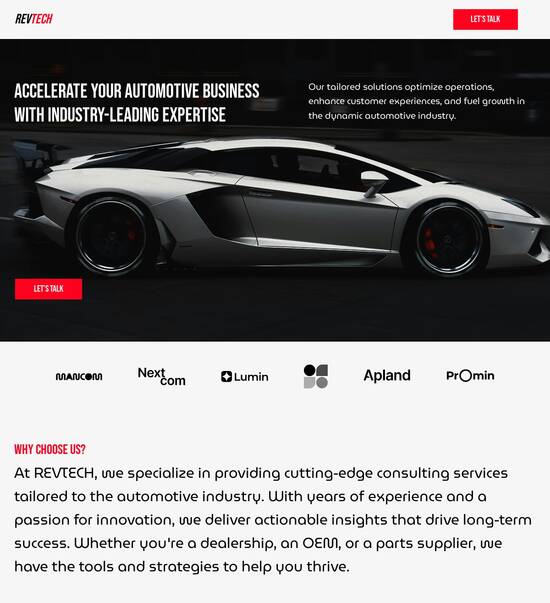
Web page template for Full stack developers
Use TemplateAbout template
Attract clients and showcase your skills with style using our landing page templates for Full stack developers. Let's convert those visitors into clients!
Recommended templates

Easy to build without coding
With the intuitive drag-and-drop builder, anyone on your team can create high-converting pages without any knowledge of code or design. Make enhancements to your landing page with custom widgets using Javascript, HTML/CSS, or third-party scripts.

Multiple layouts for any industry and goal
Select from 500+ landing page layouts built to boost conversions across industry-specific scenarios. Customize them by adjusting fonts, adding images, and generating on-brand content with the AI assistant. Quickly scale with Instablocks® and Global Blocks that you can save, reuse, and update globally.

Loads fast and looks polished on any device
Every template is responsive, which means they present professionally on any device and load blazingly fast with our Thor Render Engine. You can also power them up with Google AMP technology to deliver an unparalleled mobile experience and drive higher conversions.

Robust analytics & experimentation
Get real-time updates and reporting across all your devices, showing the number of visitors, conversions, cost-per-visitor, and cost-per-lead. Launch AI-powered experiments, run A/B tests, and use heatmaps to analyze user behavior, then optimize your landing page to maximize conversions.







Easy to build without coding
With the intuitive drag-and-drop builder, anyone on your team can create high-converting pages without any knowledge of code or design. Make enhancements to your landing page with custom widgets using Javascript, HTML/CSS, or third-party scripts.
Multiple layouts for any industry and goal
Select from 500+ landing page layouts built to boost conversions across industry-specific scenarios. Customize them by adjusting fonts, adding images, and generating on-brand content with the AI assistant. Quickly scale with Instablocks® and Global Blocks that you can save, reuse, and update globally.
Loads fast and looks polished on any device
Every template is responsive, which means they present professionally on any device and load blazingly fast with our Thor Render Engine.
Robust analytics & experimentation
Get real-time updates and reporting across all your devices, showing the number of visitors, conversions, cost-per-visitor, and cost-per-lead. Launch AI-powered experiments, run A/B tests, and use heatmaps to analyze user behavior, then optimize your landing page to maximize conversions.
All the features you need to build lead-generating landing pages
Explore more featuresLearn how to build top-performing landing pages for any goal
FAQs
Leading the way in building high-performing landing pages





A comprehensive guide to instapage for maximizing your digital marketing campaigns
Instapage stands out as a premier landing page and conversion rate optimization (CRO) platform designed to enhance the effectiveness of your digital marketing efforts. Whether you're managing campaigns in business services, tech, education, or financial services, Instapage offers a user-friendly solution tailored to meet your needs. This guide will walk you through a step-by-step process of utilizing Instapage to boost your marketing endeavors, ensuring you achieve optimal return on investment (ROI).
Creating stunning landing pages effortlessly
The process begins with choosing from an extensive library of over 100 templates that are specifically designed for high conversion. With user-friendly drag-and-drop builders, you can create visually appealing landing pages without any coding knowledge. Here are some advantages of using Instapage's templates:
- Versatile Designs: Select from layouts that suit your target audience in diverse sectors like education or financial services.
- Built-in Lead Generation: Templates come equipped with essential elements to capture leads right off the bat.
- Time Efficiency: Quickly customize templates to launch campaigns faster and remain agile in your marketing strategies.
Optimizing for Conversion: A/B Testing and Analytics
Once your landing page is up, ongoing optimization is critical. Instapage provides integrated A/B testing features to evaluate different versions of your page. Start by implementing these steps:
- Setup A/B Tests: Create multiple variations of your landing page to assess which performs better.
- Analyze Heatmaps: Use detailed heatmap analytics to understand user interactions and behaviors.
- Performance Review: Consistently check the analytics dashboard to tweak your pages based on real-time data.
Personalizing Content for Unique Audiences
To achieve better engagement, utilize Instapage's personalization features to cater to specific segments of your audience. Customize messages using dynamic text replacement based on user data. Consider the following methods:
- Dynamic Text: Adjust text on landing pages based on the visitor’s source or previous interactions.
- Ad Mapping: Align specific ads with dedicated landing pages that speak directly to the ad’s message.
- Audience Tracking: Monitor performance metrics at the audience level to better understand their preferences.
Utilizing Instapage effectively helps create tailored marketing experiences, ultimately driving higher conversions.
By following this guide, you can confidently use Instapage to enhance your landing page strategy, making it a vital tool for your marketing toolkit.
Ready to elevate your marketing campaigns? Start your free trial with Instapage today and explore the powerful tools available to optimize your landing pages.
People also ask about Web page template for Full stack developers
Web page templates for full stack developers
The significance of web page templates for full stack developers
Web page templates play a pivotal role in the daily routines of full stack developers. These templates serve as foundational elements that streamline both the design and functionality of web applications. By offering a pre-built structure, web page templates allow developers to focus more on core features and backend logic rather than getting bogged down in the nitty-gritty of layout design.
Definition-wise, a web page template is a pre-designed webpage which consolidates various UI elements that developers can utilize in their projects. This not only aids in maintaining a consistent look and feel but also significantly speeds up the development cycle. The importance of templates becomes apparent when you consider the rapidly changing landscape of web development, where time and flexibility are paramount.
Faster turnaround time in project development.
Enhanced focus on backend processes due to reduced frontend workload.
Higher consistency in design, leading to better user experiences.
Bridging the gap between frontend and backend development
The synergy between design and functionality is one of the key benefits of applying web page templates in full stack development. Fool-proof templates ensure developers don’t have to juggle multiple responsibilities without an aligned vision, improving both aesthetics and functionality in the final product.
With standardized templates, collaboration between frontend and backend developers becomes smoother. Communication is facilitated as the expectations for how components should interact are clearly set from the beginning. This leads to fewer back-and-forth exchanges, which ultimately enhances productivity.
Comprehensive overview of template features tailored for developers
Templates offer a wealth of features that are particularly beneficial for developers. One of the standout features is the modular and reusable design elements. This allows developers to create efficient design workflows where sections or components can be reused across different projects or parts of a single project. Such modularity can drastically reduce time spent on re-designing elements and ensure a cohesive feel throughout multiple pages.
Encourages the use of reusable components, which saves time.
Enhances team flexibility, allowing for simultaneous development.
Offers a structured approach that minimizes design discrepancies.
Adaptive layouts are another key component, ensuring that designs remain responsive across various devices. This is increasingly important in today's digital environment where a significant portion of web traffic comes from mobile devices. Techniques for achieving fluid scalability include using CSS flexbox or grid systems, which allow components to adjust dynamically to different screen sizes.
Customization capabilities further enhance the attractiveness of web page templates. Developers can leverage popular frameworks and libraries, making it easy to extend the functionality of a template to meet specific project needs. This means transforming a standard template into a tailored solution without starting from scratch.
Crucial aspects of template design that enhance developer productivity
Standardization of components stands as a monumental aspect of template design. It ensures consistency and predictability across various projects. With the adoption of standardized components, developers can rely on well-documented and widely understood functions, reducing the learning curve for new team members and promoting faster onboarding.
Furthermore, connecting the frontend with backend services becomes significantly easier. Employing clear templated structures enhances how frontend and backend components communicate, especially when working with APIs. Framework-aware design practices, where the template is designed keeping the target framework in mind, simplify integration and help streamline the development process.
Improves communication between developers and non-developers.
Encourages sustainable coding practices.
Simplifies updating and maintaining projects, saving time in the long run.
Moreover, workflow enhancement is vital for any development team. Using Kanban templates enables developers to manage tasks efficiently. Organizing tasks visually through categorizations can streamline workloads and make project management far more effective.
Key tasks and processes involved in using web page templates
When beginning a project with web page templates, laying the foundation is crucial. The initial setup steps often involve selecting a template that aligns closely with the project’s goals. Customization can then occur based on specific requirements, ensuring that the selected template can deliver the desired results effectively.
Frontend development approaches also matter here. Full stack developers can choose between using JavaScript frameworks or traditional methods to implement their templates. Prebuilt components save valuable time and minimize the hassle of building functionalities from scratch, allowing developers to focus on integrating them into the overall structure.
Reviewing various templates to select the one that meets needs.
Customizing templates to align with specific branding or functionality.
Testing responsiveness across different devices to ensure user satisfaction.
Backend integration techniques are equally critical. Establishing seamless connectivity between server and client-side code ensures a smooth user experience. This involves leveraging well-structured APIs and incorporating secure authentication methods, thus adhering to best practices in security.
Tracking progress: utilizing templates for enhanced project management
Utilizing web page templates can lead to considerable enhancements in project management. Breaking down projects into manageable tasks allows development teams to excel in delivering projects on time. Good techniques for task breakdown often incorporate prioritization strategies for development phases, helping the team clearly understand the most crucial elements to address first.
Maintaining visibility over the workflow is paramount, particularly in collaborative environments. Team members can use dashboards to track progress, allowing everyone to stay on the same page. Setting up performance metrics can enable teams to measure success quantitatively, providing contextual insights into productivity and efficiency.
Incorporating regular team check-ins to assess project status.
Employing project management tools tailored to web development needs.
Creating structured documentation that reflects any changes made throughout the project.
Adapting to team demands and implementing feedback loops can be transformative. Agile methodologies incorporated into template-driven projects yield great results, allowing for frequent reassessments and adjustments based on user feedback and development challenges.
Evaluating the benefits of web page templates for development teams
The boost in development speed is one of the most obvious benefits of using web page templates. By leveraging templates, developers can significantly reduce their time-to-market. Companies that have adopted templates often report case studies illustrating substantial time savings—from days to weeks—when deploying new web applications or features.
Collaboration and communication within teams also see a marked improvement. Tools specifically designed for template projects create environments that facilitate teamwork and clear lines of communication. Best practices include regular updates and feedback sessions, ensuring everyone involved can maintain alignment as projects progress.
Increased adaptability to client needs through rapid iterations.
Better risk management via early identification of potential issues.
Enhanced satisfaction through timely deliveries and motivated teams.
Moreover, templates can greatly reduce overall development and maintenance costs. Utilizing standardized components fosters a predictable and efficient coding environment that minimizes the debugging process, thus saving developers time and companies money in the long term.
Innovation in template use: designing for future development trends
Innovation in the realm of web page templates is vital, especially as the industry trends shift towards low-code development platforms. Templates seamlessly fit into low-code environments, enabling rapid prototyping and the creation of minimum viable products (MVPs). This flexibility can empower full stack developers to bring ideas to fruition without extensive coding.
Evolving user expectations, particularly regarding personalization and customization, are changing how templates are designed. Developers are increasingly required to deliver tailored experiences, pushing them to innovate on current practices. Techniques for leveraging templates effectively can include implementing content that is customizable at multiple levels, ensuring every user feels engaged.
Designing templates that prioritize user-centric principles.
Utilizing advanced analytics to inform template adjustments.
Developing templates that can easily adapt to emerging technologies.
Future-proofing templates is crucial as emerging technologies like artificial intelligence, machine learning, and Internet of Things (IoT) continue to evolve. Developers must remain vigilant to trends in web standards and practices to keep templates both versatile and relevant, ensuring they meet consumer demands over time.
Ready to skyrocket conversions?
Supercharge your ad campaigns with high-performing landing pages
Get started














